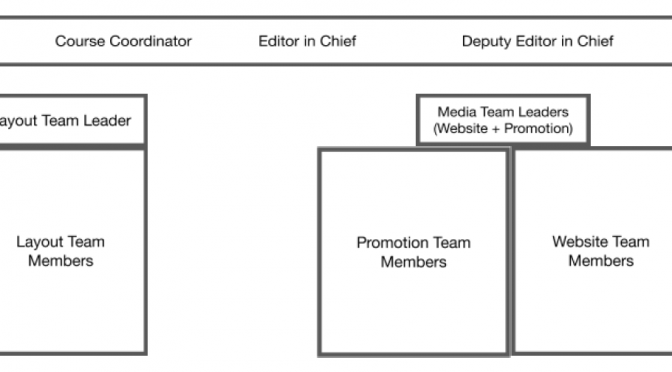- What exactly is the
course called and how does it fit into the study program? What English skills
are being covered? And how do you learn the required writing skills?
The
course has a rather unspectacular name: it goes by Integrated Language Skills (LPO 2012) /
Integrated Language Skills 2 (LPO 2008) (eMag). eMAG is part of a
module that consists of three courses, the other two being Effective Writing
and Übersetzung Englisch-Deutsch (1). eMAG fits in here as an
opportunity for students to put the skills they have learned in those other
courses to practical use in an authentic, english-speaking environment. The
eMAG course itself is there to improve students’ writing skills outside of the
usual term paper style. We try to convey a more informal writing style in
general.
- eMAG has a very
project-based way of practising writing skills. Would you say this is more
promising for participants than a traditional class?
I’m going
to go with the diplomatic route here and say that a good mix between a
theoretical approach and a practical one is very useful. You can’t learn a
language simply by reading about it. You have to use it to actual get better at
it. And a part of that certainly is writing, too, in all its forms. But at the
same time, it’s also necessary to have a good foundation to start working on a
project like eMAG. You need to have some basic understanding of how to
structure your writing, that there are differences between writing in German
and English – and that does include formal differences. And that is something
we wouldn’t be able to do in just one term with one session a week. In a
nutshell, I’d say that eMAG is a great opportunity if you have the necessary
foundations.
- For us, organisational
tasks took up a lot of time and it wasn’t quite clear who was responsible for
what. Also, what presented a bit of a struggle was that our course is supposed
to teach writing skills before all else but the magazine focus didn’t allow
much time for that. How do you handle organizational tasks within a writing
course?
It’s good
to see that similar projects are struggling with similar problems. There is no
way around it and I was lucky enough to join the course at a time when a lot of
these issues had already been dealt with and solved. There already was a good
routine that people before me had set up. The trick is to give the course a
real project structure with different layers of who would be responsible for
what – teams for layouting and media and advertisement to just name a few.
Within these groups, the regular members, who take the course for credit
points, will mostly focus on writing and only take on smaller tasks to help
create the final magazine. The experienced staff, on the other hand, get clear
assignments on what needs to be done. In the end, the editor-in-chief has the
fun task of managing and overseeing all those groups and bringing everything
together.
- Who is eligible to join
the class, i.e. students of what semester or year of the study program? How
many are you in total and what is the ratio between students who do the course
voluntarily and those who do it for credit points? Do both of these groups
participate in the same way?
There is
no real condition set for joining the class, especially if you’re studying
English: if you need the credit points, who are we to tell you you can’t come?
We do prefer for the people to have completed the writing part of the module
beforehand, or at least to be taking that class in the same term, but we can’t
enforce that. Naturally, though, most people are doing it this way because
following the module structure makes the most sense. In turn, that means that
most new members are in or around their 3rd semester. In terms of
how many people join, there’s some fluctuation: there are usually more
participants during winter terms, but it’s roughly 20-25 people in general.
Only few of these aren’t English students – although I wouldn’t say there’s a
difference in participation. On top of that, there is my team which consists of
seven people at the moment. These tend to be people who have participated
before and can’t get any more credit points. They are just there for a good
time.
- In our course, we tried
to assign different roles to different people. However, we didn’t define
clearly enough what each role’s job was, leading to the point where some people
did much more work than others. What roles do you have within your team? And
what tasks does each role involve? Is the work distributed in a rather even
way, or are there also differences between the work load of different people?
I think this little chart from our guidelines does a better
job at visualizing this than I could in words:
The new members are being split into either working on layouts or promoting the
magazine, apart from working on their articles. Both teams are supervised by
team leaders who know how everything is supposed to be structured and help out
wherever necessary. If even they don’t know the solution, it’s usually my part
to figure something out. Problem solver would probably be one of the better
descriptions for what I do. There is a lot of organizing things behind the
scenes, too, of course: finding printers, organizing everything to be in line
with our university and making decisions on how to go forward or cutting
inappropriate articles, though we do try to avoid that at all costs.
Nonetheless, it happens every once in a while.
We
struggled a lot to find a good balance between the workload of the layout team
compared to the media team. Layouting is just such a time-consuming but
necessary part of it all that it makes it difficult to cut down on it, yet the
media team usually doesn’t face quite as many tasks throughout the term. Last
term we struck a good balance by giving each member of the Media team the task
to write one additional article which would be published on our website while
the layout team didn’t get that assignment. This lead to the workload being
evened out for the most part.
Apart
from that, there’s Writing Support, a team that consists of three experienced
eMAGgers. Their job is to correct early drafts and give feedback, before the
final draft goes to the course coordinator.
- What does your lecturer
do exactly? What is their role in the production of each magazine? And how do
they grade each person’s work?
The
entire course is supposed to be run by students. But as we wouldn’t be allowed
to give people credit, Mr. Jehle is the one who’s in charge officially. Until
last term, it was Mr. James, who founded eMAG. The lecturer’s job is to
organise exams and talk to the higher-ups of our university in case there are
issues we couldn’t solve by ourselves. They also correct final article drafts
so we do get some professional feedback.
As for grading, that’s a mystery, even to me. I think it’s really just magic…
Ideally, though, we would love to be able to grade the work during the course
and skip the exam entirely, but as we are part of the entire three-part module
structure, we have to offer an exam which is also created by our course
coordinator. Since the class takes up more time than a regular course, though,
we try not to put additional work on participants for exam preparation. The aim
is to create an exam that can be answered relatively easily by any regular
class member.
- We heard that your
editors are meeting every week with the lecturer – what is being discussed in
those weekly meetings?
Another
rather boring answer: it’s just to catch up on things that are going on. Making
sure nothing’s being overlooked or forgotten about. Mr. James’ experience in
this matter was invaluable. He didn’t encounter most problems for the first
time, so he knew how to handle things if something went awry. And there tends
to be at least one thing each term that does.
- How do you organize the
advertisement for your magazine?
At this
point, we have a few contract partners that have been advertising in eMAG for a
long time, which makes the process a lot easier: they know exactly what needs
to be done once we come around and ask if they’re still interested. The process
consists of two steps: first off, we need to get the contracts signed by our
partners who then in turn will send us their ad. This ad is then being handled
like a regular magazine page and copied into inDesign. After that, we need to
deal with the entire bureaucratic process of handing in the contracts to our
university. The people in charge then check if they are all legally printable
and if any mistakes have been made. If everything is found to be in order, they
write the bill.
- Our first magazine
didn’t have a general topic, and everyone just wrote about whatever they were
interested in. However, we think it will be better if our magazine has that
kind of topic for each semester’s edition from now on. How do you decide on a
topic for each term?
That’s
one of the funnier parts of class! During one of the last sessions each term we
dedicate one hour to brainstorming ideas on what could be interesting as a
topic. It must be a topic that hasn’t been covered yet, of course. Once we have
a list of potential topics, everyone gets to vote on what will be the Main
Topic for the following issue. We usually go with that decision, but I remember
a few terms ago when more than 90% of people voted on a topic that we ended up
not taking. My deputy and I decided on the topic Misfits instead, although that
topic only had two votes, coming from the both of us. Guess that’s one of the
few perks of being editor-in-chief.
- How do you manage a deadline as early in the semester as one month
after it started? And what do you do afterwards?
For
everything to go as smoothly as possible, the team and I sit down during the
term break to plan everything out with a very strict schedule. Experience, of
course, already plays into this, so we kind of know how well some deadlines
will work out or how much time you really need to give people with certain
assignments to get reasonable results. Then, one week before the term actually
starts, I write an e-mail to the course and give the participants all the
details, so everyone is already well-prepared and know what’s coming. That
method has been working out for us pretty well.
- Do some of your Lehramt students plan on using the skills and ideas
from your magazine project later on, in the school classroom?
As I’m
not going to become a teacher, I can only make assumptions here, but I think
working in a team project like eMAG definitely makes organizing a bit easier
later on, when you want to get anything done with a horde of 30 pupils. I look
at it realistically, though, and say that it’s most likely not going to be a
magazine in and of itself. What is useful, I would imagine, is the skills you
learn without even noticing for the most part: Working in a team, problem
solving, time management. Skills that are becoming more and more important in
our society. So maybe that is our little contribution to the development of our
students in the course. I, at least, hope so and, most importantly, that it’s a
fun time for everyone in what’s otherwise often a very monotonous university
day.




